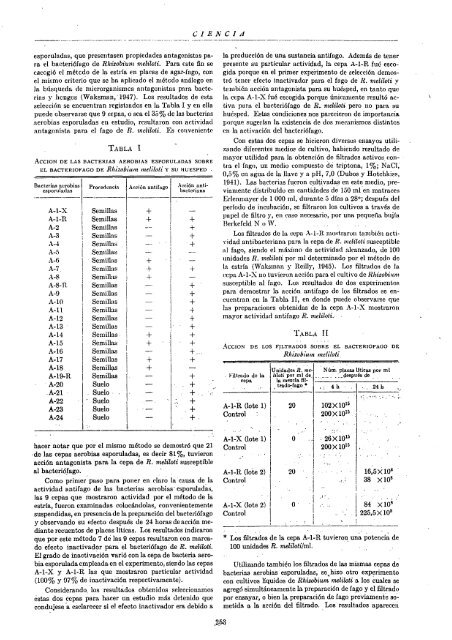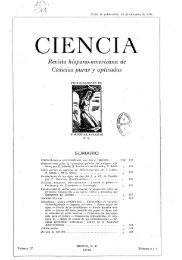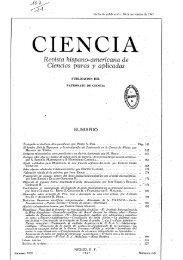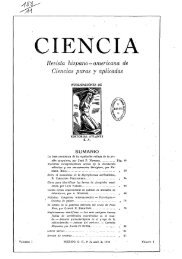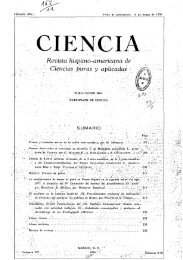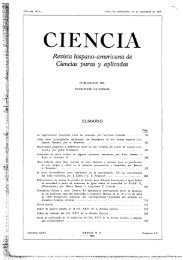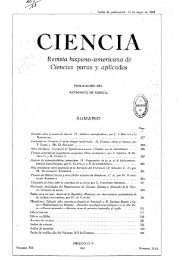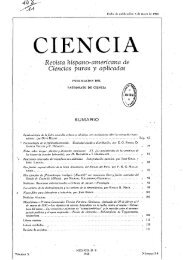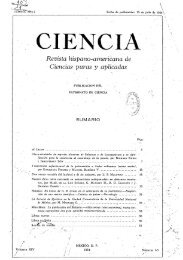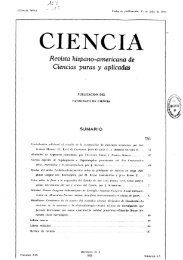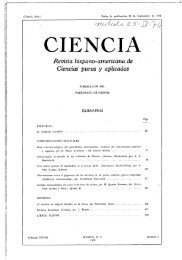Número 10-12 - Instituto de Historia de la Medicina y de la Ciencia ...
Número 10-12 - Instituto de Historia de la Medicina y de la Ciencia ...
Número 10-12 - Instituto de Historia de la Medicina y de la Ciencia ...
You also want an ePaper? Increase the reach of your titles
YUMPU automatically turns print PDFs into web optimized ePapers that Google loves.
--_ ...... __ ... _----------. --_.-.- .... - .. --.. _._.<br />
CIENCl,l<br />
esporu<strong>la</strong>du8, que presentasen propieda<strong>de</strong>s antagonistas para<br />
el bacteri6fllgo <strong>de</strong> RhizobiulIl meliloti. Para este fin se<br />
cecogió el métcdo <strong>de</strong> <strong>la</strong> estr<strong>la</strong> en p<strong>la</strong>cas <strong>de</strong> agar-fago, con<br />
el miEDlO criterio que se ha aplicado el métcdo análogo en<br />
<strong>la</strong> blísqueda <strong>de</strong> microrganismos antagonistas para bacterias<br />
y hongos (Waksman,1947). Los resultados <strong>de</strong> esta<br />
selección se encuentran registrados en <strong>la</strong> Tllb<strong>la</strong> 1 y en el<strong>la</strong><br />
pue<strong>de</strong> observarse que 9 CEpas, o sea e135% <strong>de</strong> <strong>la</strong>s bacterias<br />
aerobias esporu<strong>la</strong>das en estudio, resultaron con actividad<br />
antagonista para el fago <strong>de</strong> R. meliloli. Es conveniente<br />
TABLA 1<br />
ACCION DE LAS BACTERIAS AEROBIAS ESPORULADAS SOBRE<br />
EL BACTERIO~'AGO DE Rhizobium lIu/iloli Y SU HUESPED .<br />
BacteriM nerobilUl Proce<strong>de</strong>ncia Acción antifllgo .~cci6n nntie8poru<strong>la</strong>dns<br />
bacteriana<br />
.--------.----------1------<br />
A-1-X Semil<strong>la</strong>s<br />
A-1-R Semil<strong>la</strong>s<br />
A-2 Semi lbs<br />
A-3 Semil<strong>la</strong>s<br />
A-4 Semil<strong>la</strong>s<br />
A-5 Semil<strong>la</strong>8<br />
:\.-6 Semil<strong>la</strong>s<br />
A-7 Semil<strong>la</strong>s<br />
A-8 Semill:\.8<br />
A-8-TI. Semil<strong>la</strong>s<br />
A-U Semil<strong>la</strong>s<br />
A-lO Semil<strong>la</strong>s<br />
A-11 Semil<strong>la</strong>s<br />
A-<strong>12</strong> Semil<strong>la</strong>s<br />
A-13 Semil<strong>la</strong>s<br />
A-14 Semil<strong>la</strong>s,<br />
A-15 Semil<strong>la</strong>s<br />
A-16 Semil<strong>la</strong>s<br />
A-17 Semil<strong>la</strong>s<br />
A-18 Semilll,lS<br />
A-l9-R Semil<strong>la</strong>s<br />
A-20 Suelo<br />
.A-21 Suelo·<br />
A-22 Suelo<br />
A-23 Suelo<br />
A-24 Suelo<br />
+<br />
+<br />
+<br />
+<br />
+<br />
+<br />
+<br />
+<br />
+<br />
+<br />
+<br />
+-<br />
+<br />
+<br />
+<br />
+ ...<br />
+<br />
+<br />
+<br />
+.<br />
hacer notar que por el mismo método se <strong>de</strong>mostró que 21<br />
·<strong>de</strong> <strong>la</strong>s cepas aerobias esporu<strong>la</strong>das, es <strong>de</strong>cir 81 %, tuvieron<br />
acción antagonista para <strong>la</strong> cepa <strong>de</strong> R. meliloti susceptible<br />
al bacterió!ago.<br />
Como primer' paso para poner en c<strong>la</strong>ro <strong>la</strong> causa <strong>de</strong> <strong>la</strong><br />
actividad antifago <strong>de</strong> <strong>la</strong>s bacterias aerobias' esporu<strong>la</strong>das,<br />
<strong>la</strong>s 9 cepas que mostraron actividad por el método <strong>de</strong> <strong>la</strong><br />
estría, fueron examinadas colocándo<strong>la</strong>s, convenientemente<br />
suspendidas, en presencia <strong>de</strong> <strong>la</strong> preparación <strong>de</strong>l bacteri6fago<br />
y observando su efecto <strong>de</strong>spués <strong>de</strong> 24 horas <strong>de</strong> acci6n mediante<br />
recuentos <strong>de</strong> p<strong>la</strong>cas líticas. Los resultados indicaron<br />
que por este método 7 <strong>de</strong> <strong>la</strong>s 9 cepas resultaron con marcado<br />
efecto inactivador para el bacteriófago' <strong>de</strong> R. meliloti.<br />
El grado <strong>de</strong> inactivación 'Varió con <strong>la</strong> cepa <strong>de</strong> bacteria aerobia<br />
esporu<strong>la</strong>da empleada en el experimento, siendo <strong>la</strong>s cepas<br />
A-1-X y A-1-R <strong>la</strong>s que mostraron particu<strong>la</strong>r actividad<br />
(<strong>10</strong>0% y U7% <strong>de</strong> inactivación respectivamente).<br />
Consi<strong>de</strong>rando; los resultádos obtenidos seleccionamos<br />
estas dos cepas pam hacer un estudio más <strong>de</strong>tenido que<br />
condujese 'a esc<strong>la</strong>recer si el efecto inactivador era <strong>de</strong>bido a<br />
<strong>la</strong> producción <strong>de</strong> UDa sustancia antifago. A<strong>de</strong>más <strong>de</strong> tener<br />
presente su particu<strong>la</strong>r actividad, In. cepa A-1-R fué escogida<br />
porque en el primer expe'rimento <strong>de</strong> selección <strong>de</strong>most.ró<br />
tener efecto inactivador para el fago <strong>de</strong> R. meliloti y<br />
t.!!ll1bién acción antagonista para su huésped, en tanto quc<br />
<strong>la</strong> cepa A-I-X fué escogida porque únicamente resultó activa<br />
pum el baeteriófago <strong>de</strong> R., meliloti pero no para ~u<br />
huésped. Estas condiciones nos parecieron <strong>de</strong> importancia<br />
porque sugerían <strong>la</strong> existencia <strong>de</strong> dos mecanismos distintcs<br />
en <strong>la</strong> activación <strong>de</strong>l bacteriófago.<br />
Con estas dos cepas se hicieron diversus ensayo!> utilizando<br />
diferentes medios <strong>de</strong> cultivo, habiendo re¡mltado <strong>de</strong><br />
mayor utilidad para <strong>la</strong> obtención <strong>de</strong> filtrados activos contra.<br />
el fago, un medio compuest.o <strong>de</strong> triptona, 1 %; NaCI,<br />
0,5% en agua <strong>de</strong> <strong>la</strong> l<strong>la</strong>vc y a pH, 7,0 (Dubos y Hotchkiss,<br />
1941). Las bacterias fucron cultivadas en este medio, previamente<br />
distribuIdo el~ cantida<strong>de</strong>s dé 150 mI en matraces<br />
Erlenmayer <strong>de</strong> <strong>10</strong>00 mI, dUl'ante.5 días a 28°; <strong>de</strong>spués <strong>de</strong>l<br />
período <strong>de</strong> incubación, se filtraron los cultivos a través <strong>de</strong><br />
papel <strong>de</strong> filtro y, en caso necesario, por una pequeI1a bujía<br />
Berkefeld N o W.<br />
Los filtrados <strong>de</strong> <strong>la</strong> eepa A-I-R 1ll0Ht,rarUII tumbit5n adi<br />
\·idad antibacteriana para <strong>la</strong> cepa <strong>de</strong> R. mcliloti suscept,ible<br />
al fago, siendo el máximo <strong>de</strong> aetividud alcanzado, <strong>de</strong> <strong>10</strong>0<br />
unida<strong>de</strong>s R. meliloti por mI <strong>de</strong>terminado por el método <strong>de</strong><br />
<strong>la</strong> estría (Waksman y Reilly, 1945). Los filtrados <strong>de</strong> <strong>la</strong><br />
ecpa A-1-X no tuvieron acción para el eultivo <strong>de</strong> Rhizobillm<br />
susceptible al fago. Los resultados <strong>de</strong> dos experimentos<br />
para <strong>de</strong>mostrar <strong>la</strong> acción antifago dc los filtrados se encucntran<br />
cn <strong>la</strong> Tab<strong>la</strong> n, en don<strong>de</strong> pue<strong>de</strong> observarse que<br />
<strong>la</strong>s preparaciones obtenidas <strong>de</strong> <strong>la</strong> cepa A-I-X mostraron<br />
mayor actividad antifago R. meli/.oli.<br />
TABLA Ir<br />
ACCION DE LOS FILTRADOS SOBRE EL BACTERIOFAGO DE<br />
. Filtrado <strong>de</strong> <strong>la</strong><br />
cepa<br />
A-I-R (lote 1)<br />
I<br />
Control<br />
I<br />
"<br />
i<br />
A-1-X (lote 1) Control<br />
.' ,<br />
I<br />
-<br />
A-I-R (lote 2) I<br />
Control<br />
. ' I<br />
A-1-X (lote 2) I<br />
Controi 1<br />
Rhizobium melilo/i,<br />
U nida<strong>de</strong>!! R. meliloti<br />
por mi <strong>de</strong>.<br />
<strong>la</strong> mezc<strong>la</strong> fUtradcrfago<br />
..<br />
.,<br />
20<br />
O<br />
20<br />
O<br />
.<br />
.'<br />
.<br />
.: 4h<br />
",'<br />
",.<br />
i'<br />
i<br />
I<br />
. .1<br />
.1<br />
I<br />
I<br />
I<br />
·1<br />
I<br />
I<br />
-<br />
N úm. p<strong>la</strong>cas Uticas por mI<br />
,__ , . ·... <strong>de</strong>spués <strong>de</strong> _ ,<br />
<strong>10</strong>2X<strong>10</strong> 15<br />
200 X <strong>10</strong> 15<br />
; 26X<strong>10</strong> 15<br />
200 X <strong>10</strong> 15<br />
.J.'<br />
, , 24 h .<br />
l.: .,,!,:.;<br />
..<br />
..<br />
-<br />
"<br />
16,5X<strong>10</strong> 8<br />
38 X <strong>10</strong> 8<br />
....<br />
84 X <strong>10</strong> 8<br />
225,5 X <strong>10</strong> 8<br />
* Los filtrados <strong>de</strong> <strong>la</strong> cepa A-1-R tuvieron un~ potenci~ <strong>de</strong><br />
<strong>10</strong>0 unida<strong>de</strong>s R. meliloti/ml.<br />
Utilizando tambi~n los filtrados <strong>de</strong> <strong>la</strong>s mismas cepas <strong>de</strong><br />
bacterias aerobias esporu<strong>la</strong>das, se,hizo otro exp~rimento<br />
con cultivos líquidos <strong>de</strong> Rhizobium meliloti a los cuales se<br />
agregó simultáneamente <strong>la</strong> preparación <strong>de</strong> fa~o y el filtrado<br />
por ensayar, o bien <strong>la</strong> preparación <strong>de</strong> fugo previamente so~<br />
metida a <strong>la</strong> acción <strong>de</strong>l filtrado. ,Los resultados aparecmi


